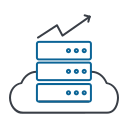One of the most comprehensive and widely adopted cloud platforms, Amazon Web Services (AWS) offers over 200 services to businesses across the globe. If you have a startup and you’re planning to use cloud services, deciding which services would be the best for your business can get quite overwhelming.
To help you in your decision-making process, we’ve compiled a list of the 8 most effective and useful AWS services for startups.
1. Amazon Elastic Compute Cloud 2 (EC2)
Amazon EC2, or Elastic Compute Cloud 2, is a startup-essential service that allows you to get virtual computers on rent for running your computer applications. It is a foundational service by Amazon on which many of the AWS services are operated. Amazon EC2 allows you to create virtual machines as well as other server management services, such as port, storage, and security. If you plan on scaling up or down, the interface is pretty straightforward and allows you to do so as per your needs.
2. Amazon Simple Storage Service (Amazon S3)
Another useful AWS cloud service for startups is Amazon Simple Storage Service (Amazon S3). It is a cloud object storage suitable for startups and offers scalability, high security, top-notch performance, and data availability. With Amazon S3’s triple-redundant storage, your startup’s data is held safely in 3 different and secure physical locations. Moreover, its FedRAMP and HITECH/HIPAA integrations keep your data and information from being compromised. Despite the presence of these critical integrations and high-security measures, there is no compromise when it comes to speed.
3. Amazon Virtual Private Cloud (Amazon VPS)
If you’re looking for an AWS cloud computing service that gives you access to a virtual private cloud, you must explore Amazon Virtual Private Cloud (Amazon VPC). Amazon VPC’s commercial cloud computing service provisions /logically isolated parts of the AWS cloud.
4. Amazon CloudFront
CloudFront by Amazon is a content delivery network (CDN). The CDN is operated by Amazon Web Services and provides a worldwide-distributed network of proxy servers that cache bulky media, like web videos. Amazon CloudFront helps boost your website/app’s speed by effectively managing your content. The AWS service offers secure and fast API, app, and data delivery so that static website files can be displayed to users from data centers across the world. CloudFront is beneficial for startups because it is offered on a “pay-as-you-go” model and no upfront fee is charged.
5. AWS Lambda
Lambda by AWS is another useful tool for startups that is responsible for running code in response to events. It is an efficient computing service that manages computing resources needed by any code automatically. This serverless, event-driven computing software is also available as a pay-as-you-go service, meaning you only pay for the computing time you use. If your startup is overwhelmingly loaded with requests that your current infrastructure isn’t able to handle, Lambda will help take care of those requests.
6. Amazon Simple Notification Service (Amazon SNS)
A great way to remind your userbase of using your services is through notifications and emails. It is especially helpful if you have a startup and you have an app that your customer base can use. Amazon Simple Notification Service (SNS) is an easy-to-use service for sending notifications to your customers. SNS suppers text messaging across 200 countries, email notifications, and mobile push notifications to Android, Amazon, Apple, Microsoft, and Baidu devices.
SNS aims at making communicating with your customers easier by providing many-to-many endpoint-messaging-as-a-service. Moreover, it enables your startup to send SQS and HTML notifications on any platform, be it Android, iOS, or web. SNS can be integrated with any app that’s operating on NodeJS, PHP, etc.
7. AWS Fargate
Fargate by Amazon Web Services (AWS) is one of the most useful and best AWS services for startups. Fargate, a serverless technology, allows you to run and operate containerized applications that do not require you to manage any servers. Using this AWS technology will eliminate the need for you to choose server types, optimize cluster packing, or make decisions on when to scale clusters. It is a pay-as-you-go service that enables you to focus on building groundbreaking applications without having to worry about servers.
8. Amazon Elasticache
With people’s attention span and patience with load time going down, optimizing your website/app speed is crucial. AWS Elasticache is Amazon’s free data caching service that, instead of depending on slower disk-based databases, enhances web app performance by retrieving data from the managed in-memory cache.
Using AWS Elasticache reduce latency significantly for web apps with heavy-to-read workloads. This AWS service is especially popular in startups that are focused on developing Gaming, Healthcare, IoT, and Advertising Technology applications.
There are many other services by Amazon Web Services that startups leverage to level up. If you plan on integrating AWS into your business operations, GoDgtl offers top-notch AWS managed services. We are an AWS Advanced Consulting Partner and can help you figure out your cloud requirements.



















